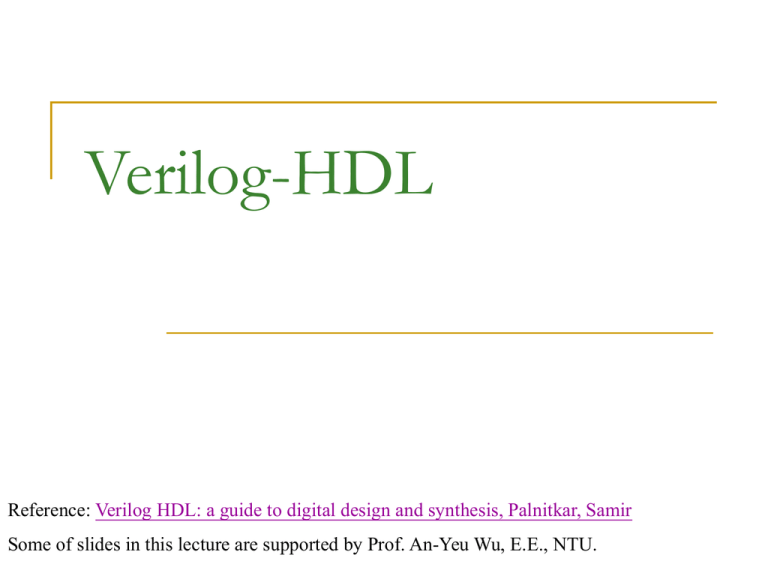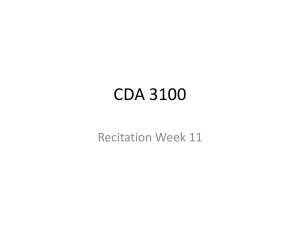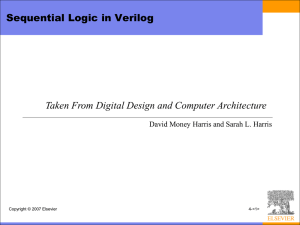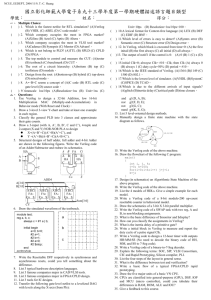Verilog-HDL
advertisement

Verilog-HDL
Reference: Verilog HDL: a guide to digital design and synthesis, Palnitkar, Samir
Some of slides in this lecture are supported by Prof. An-Yeu Wu, E.E., NTU.
OUTLINE
Introduction
Basics of the Verilog Language
Gate-level modeling
Data-flow modeling
Behavioral modeling
Task and function
Verilog HDL (continue)
• Invented by Philip Moorby in 1983/ 1984 at
Gateway Design Automation
• Enables specification of a digital system at a range
of levels of abstraction: switches, gates, RTL, and
higher
• Initially developed in conjunction with the Verilog
simulator
Verilog HDL
• Verilog- based synthesis tool introduced by Synopsys in
1987
• Gateway Design Automation bought by Cadence in
1989
• Verilog placed in public domain to compete with VHDL
– Open Verilog International (OVI) IEEE 1364 -1995
and
revised version IEEE 1364 -2001
revised version IEEE 1364 -2005
For more details, please read the document of IEEE
Standard for Verilog® Hardware Description Language
What is Verilog HDL ?
Mixed level modeling
Behavioral
Structural
Algorithmic ( like high level language)
Register transfer (Synthesizable)
Gate (AND, OR ……)
Switch (PMOS, NOMS, JFET ……)
Single language for design and simulation
Built-in primitives and logic functions
User-defined primitives
Built-in data types
High-level programming constructs
Basic Conventions
Verilog is case sensitive
– Keywords are in lowercase
Extra white space is ignored
– But whitespace does separate tokens
Comments
– One liners are //
– Multiple lines /* */
– Comments may not be nested
OUTLINE
Introduction
Basics of the Verilog Language
Overview of Verilog Module
Identifier & Keywords
Logic Values
Data Types
Numbers & Negative Numbers
Gate-level modeling
Data-flow modeling
Behavioral modeling
Task and function
Overview of Verilog Module
Test bench
Basic unit --Module
module module_name (port_name);
port declaration
data type declaration
module functionality or structure
endmodule
D-FlipFlop
module D_FF(q,d,clk,reset);
output q;
//port declaration
input d,clk,reset;
reg q;
// data type declaration
always @ (posedge reset or negedge clk)
if (reset)
q=1'b0;
else
q=d;
endmodule
Instance
A module provides a template which you can
create actual objects.
When a module is invoked, Verilog creates a
unique object from the template
The process of creating a object from module
template is called instantiation
The object is called instance
Instances
module adder (in1,in2,cin,sum,cout);
.......
endmodule
Mapping port positions
module adder8(....) ;
adder add1(a1,b1,1’b0,s1,c1) ;// assign by order
add2(.in1(a2),.in2(b2),.cin(c1),.sum(s2)
,.cout(c2)) ;// assign by name, the order is
changeable
Mapping names
.....
endmodule
q
T-FlipFlop
。
d
q
module T_FF(q,clk,reset);
clk
○
output q;
input clk,reset;
wire d;
D_FF dff0(q,d,clk,reset); // create an instance
not n1(d,q);
endmodule
Identifier & Keywords
Identifier
User-provided names for Verilog objects in the descriptions
Legal characters are “a-z”, “A-Z”, “0-9”, “_”, and “$”
First character has to be a letter or an “_”
Example: Count, _R2D2, FIVE$
Keywords
Predefined identifiers to define the language constructs
All keywords are defined in lower case
Cannot be used as identifiers
Example:initial, assign, module, always….
Hierarchical Modeling Concepts
Top level block
Subblock 1
Leaf
cell
Leaf
cell
Subblock 1
Leaf
cell
Subblock 1
Leaf
cell
Leaf
cell
Leaf
cell
Subblock 1
Leaf
cell
Leaf
cell
Hierarchical Modeling Concepts
Module ripple_carry_counter(q,clk, reset);
output [3:0] q;
input clk, reset;
T_FF tff0(q[0], clk, reset);
T_FF tff1(q[1], q[0], reset);
T_FF tff0(q[2], q[1], reset);
T_FF tff0(q[3], q[2], reset);
endmodule
Hierarchical Modeling Concepts
module T_FF(q, clk, reset);
output q;
input clk, reset;
wire d;
D_FF dff0(q, d, clk, reset);
not na(d, q);
endmodule
Hierarchical Modeling Concepts
module D_FF(q, d, clk, reset);
output q;
input d, clk, reset;
reg q;
always @(posedge reset or negedge clk)
if (reset)
q=1’b0;
else
q=d;
endmodule
4-bits Ripple Carry Counter
Ripple carry
counter
T_FF
(tff0)
D_
FF
T_FF
(tff1)
Inver
ter
D_
FF
T_FF
(tff2)
Inver
ter
D_
FF
T_FF
(tff3)
Inver
ter
D_
FF
Inver
ter
Exercise
module FullAdd4(a, b, carry_in, sum, carry_out);
input
[3:0] a, b;
input
carry_in;
output
[3:0] sum;
output
carry_out;
wire
[3:0] sum;
wire
carry_out;
FullAdd fa0(a[0], b[0], carry_in, sum[0], carry_out1);
FullAdd fa1(a[1], b[1], carry_out1, sum[1], carry_out2);
FullAdd fa2(a[2], b[2], carry_out2, sum[2], carry_out3);
FullAdd fa3(a[3], b[3], carry_out3, sum[3], carry_out);
endmodule
Exercise
// FullAdd.V, 全加器
module FullAdd(a, b, carryin, sum, carryout);
input a, b, carryin;
output sum, carryout;
wire sum, carryout;
assign {carryout, sum} = a + b + carryin;
endmodule
Exercise
Implement a 16 bits full adder by using 4 bits
full adders.







